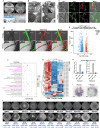Plants interfere with non-self recognition of a phytopathogenic fungus via proline accumulation to facilitate mycovirus transmission
- PMID: 38834585
- PMCID: PMC11150657
- DOI: 10.1038/s41467-024-49110-6
Plants interfere with non-self recognition of a phytopathogenic fungus via proline accumulation to facilitate mycovirus transmission
Erratum in
-
Author Correction: Plants interfere with non-self recognition of a phytopathogenic fungus via proline accumulation to facilitate mycovirus transmission.Nat Commun. 2025 Aug 11;16(1):7401. doi: 10.1038/s41467-025-62687-w. Nat Commun. 2025. PMID: 40790116 Free PMC article. No abstract available.
Abstract
Non-self recognition is a fundamental aspect of life, serving as a crucial mechanism for mitigating proliferation of molecular parasites within fungal populations. However, studies investigating the potential interference of plants with fungal non-self recognition mechanisms are limited. Here, we demonstrate a pronounced increase in the efficiency of horizontal mycovirus transmission between vegetatively incompatible Sclerotinia sclerotiorum strains in planta as compared to in vitro. This increased efficiency is associated with elevated proline concentration in plants following S. sclerotiorum infection. This surge in proline levels attenuates the non-self recognition reaction among fungi by inhibition of cell death, thereby facilitating mycovirus transmission. Furthermore, our field experiments reveal that the combined deployment of hypovirulent S. sclerotiorum strains harboring hypovirulence-associated mycoviruses (HAVs) together with exogenous proline confers substantial protection to oilseed rape plants against virulent S. sclerotiorum. This unprecedented discovery illuminates a novel pathway by which plants can counteract S. sclerotiorum infection, leveraging the weakening of fungal non-self recognition and promotion of HAVs spread. These promising insights provide an avenue to explore for developing innovative biological control strategies aimed at mitigating fungal diseases in plants by enhancing the efficacy of horizontal HAV transmission.
© 2024. The Author(s).
Conflict of interest statement
The authors declare no competing interests.
Figures





Similar articles
-
Exploration of mycovirus composition in a hypovirulent strain of Sclerotinia sclerotiorum potentially uncovers mycovirus cross-taxa transmission.Virus Res. 2025 Apr;354:199552. doi: 10.1016/j.virusres.2025.199552. Epub 2025 Feb 26. Virus Res. 2025. PMID: 40021014 Free PMC article.
-
A novel tobamo-like mycovirus with filamentous particles replicates in plant cells.J Virol. 2025 May 20;99(5):e0210224. doi: 10.1128/jvi.02102-24. Epub 2025 Mar 31. J Virol. 2025. PMID: 40162784 Free PMC article.
-
A novel partitivirus conferring hypovirulence by affecting vesicle transport in the fungus Colletotrichum.mBio. 2024 Feb 14;15(2):e0253023. doi: 10.1128/mbio.02530-23. Epub 2024 Jan 9. mBio. 2024. PMID: 38193704 Free PMC article.
-
Mycoviruses and their ecological impacts on fungi.Virology. 2025 Sep;610:110562. doi: 10.1016/j.virol.2025.110562. Epub 2025 May 6. Virology. 2025. PMID: 40413833 Review.
-
Comparative insights into soybean and other oilseed crops' defense mechanisms against Sclerotinia sclerotiorum.Front Plant Sci. 2025 Jun 24;16:1616824. doi: 10.3389/fpls.2025.1616824. eCollection 2025. Front Plant Sci. 2025. PMID: 40630728 Free PMC article. Review.
Cited by
-
Characterization of an amyloid-based antiphage defence system in Escherichia coli.Nat Microbiol. 2025 Aug 14. doi: 10.1038/s41564-025-02074-9. Online ahead of print. Nat Microbiol. 2025. PMID: 40813923
-
Exploration of mycovirus composition in a hypovirulent strain of Sclerotinia sclerotiorum potentially uncovers mycovirus cross-taxa transmission.Virus Res. 2025 Apr;354:199552. doi: 10.1016/j.virusres.2025.199552. Epub 2025 Feb 26. Virus Res. 2025. PMID: 40021014 Free PMC article.
-
New insights into RNA mycoviruses of fungal pathogens causing Fusarium head blight.Virus Res. 2024 Nov;349:199462. doi: 10.1016/j.virusres.2024.199462. Epub 2024 Sep 13. Virus Res. 2024. PMID: 39260572 Free PMC article.
-
Identification of a novel hypovirulence-inducing ourmia-like mycovirus from Fusarium solani causing ginseng (Panax ginseng) root rot.Front Microbiol. 2025 Jul 2;16:1609431. doi: 10.3389/fmicb.2025.1609431. eCollection 2025. Front Microbiol. 2025. PMID: 40673145 Free PMC article.
-
Plasmid-like dynamics of persistent RNA viruses in the host fungal population.J Virol. 2025 Aug 19;99(8):e0058225. doi: 10.1128/jvi.00582-25. Epub 2025 Jul 31. J Virol. 2025. PMID: 40742127 Free PMC article.
References
-
- Glass, N. L., Jacobson, D. J. & Shiu, P. K. The genetics of hyphal fusion and vegetative incompatibility in filamentous ascomycete fungi. Annu. Rev. Genet.34, 165–186 (2000). - PubMed
-
- Glass, N. L. & Dementhon, K. Non-self recognition and programmed cell death in filamentous fungi. Curr. Opin. Microbiol.9, 553–558 (2006). - PubMed
MeSH terms
Substances
Supplementary concepts
LinkOut - more resources
Full Text Sources

